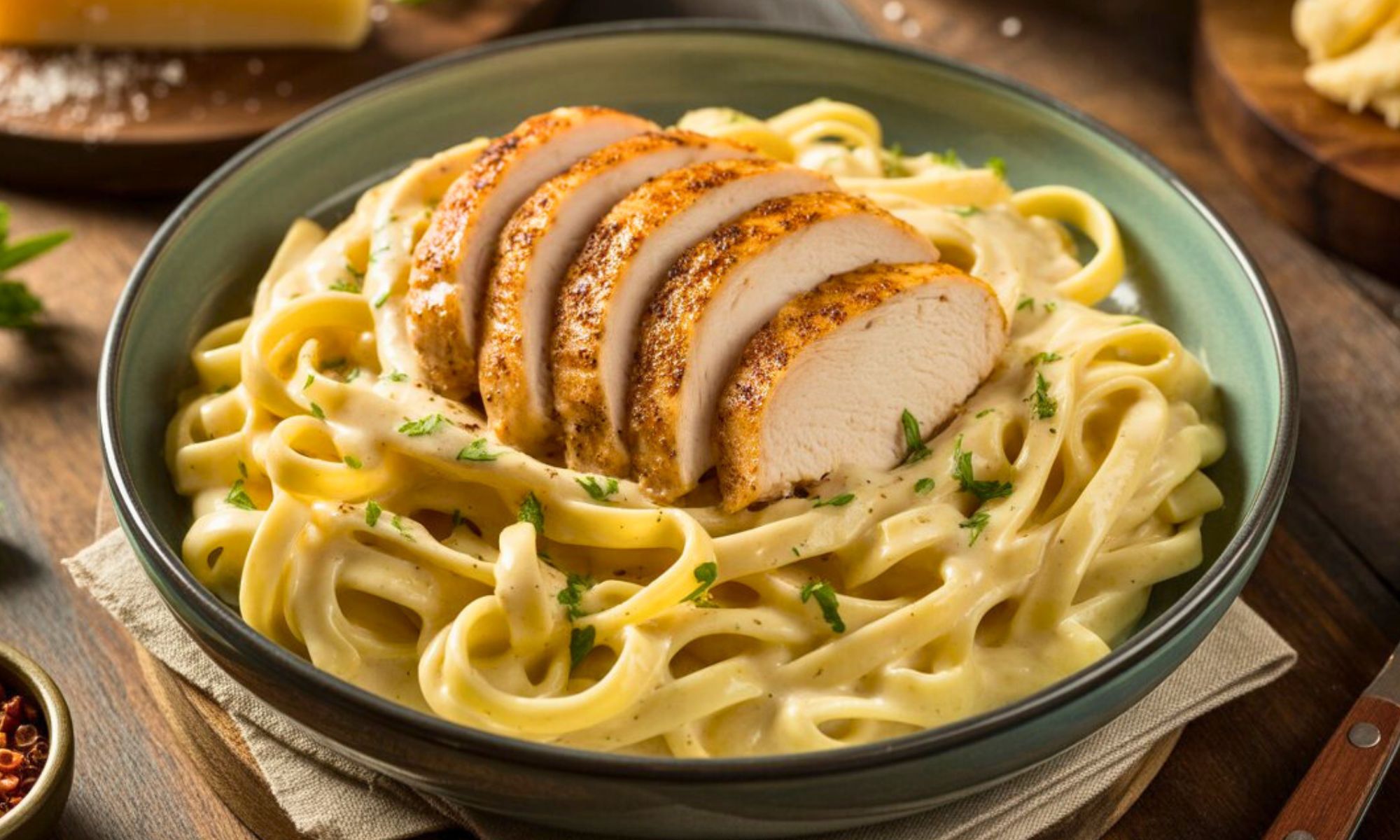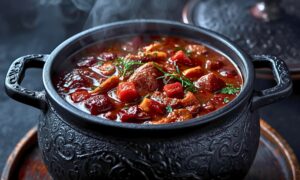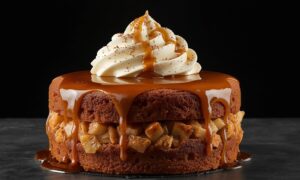Picture this: you’re scrolling through yet another recipe claiming to be “authentic Italian alfredo” when you spot heavy cream, garlic powder, and pre-shredded cheese in the ingredient list. My Italian grandmother just rolled over in her grave. Real alfredo – the kind that’ll make you weep tears of pure joy – contains exactly three ingredients: butter, Parmigiano-Reggiano, and pasta water. That’s it.
But here’s where I’m gonna break some hearts and probably get kicked out of Italy. Sometimes tradition needs a gentle nudge toward deliciousness. Today we’re creating a creamy chicken alfredo that honors the soul of classic alfredo while giving it the upgrade it deserves for modern kitchens and modern appetites.
This creamy chicken alfredo isn’t your typical heavy-cream-bomb disaster. It’s silky, sophisticated, and surprisingly light despite being ridiculously indulgent. The chicken isn’t just thrown on top like an afterthought – it’s woven into the sauce in a way that makes every bite perfect. And the best part? Once you master this technique, you’ll never go back to jarred sauce again.
Why This Creamy Chicken Alfredo Changes Everything
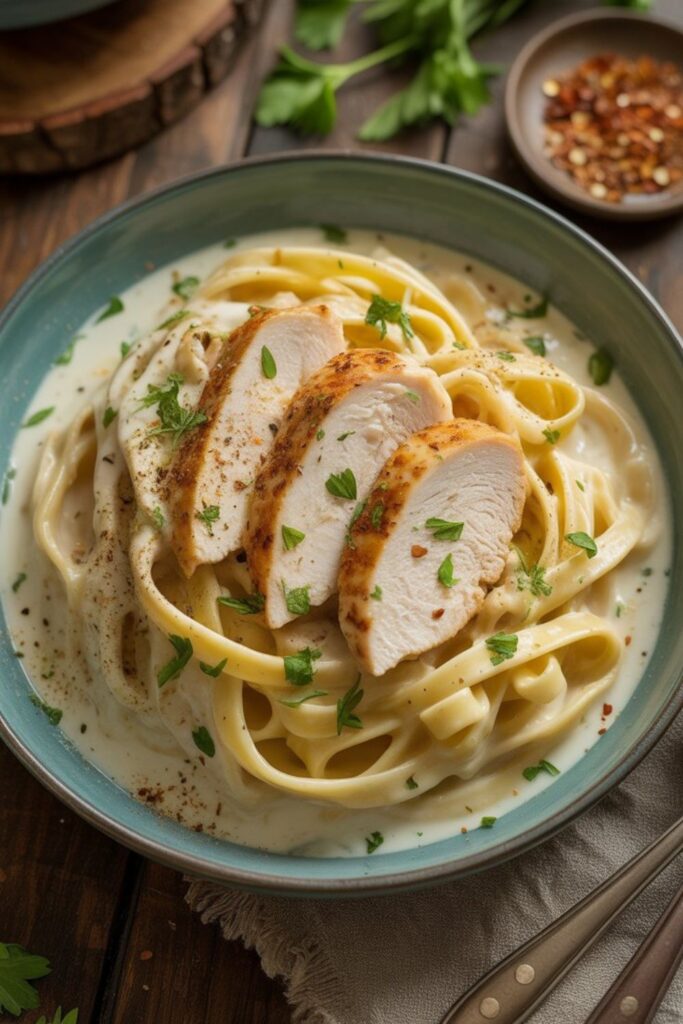
Traditional alfredo relies on pasta water and vigorous stirring to create an emulsion. Sounds simple, right? Wrong. Get the temperature slightly off and you’ve got broken, greasy disappointment. Add the cheese too fast and hello, stringy mess.
My version takes the best of both worlds. We’re keeping that gorgeous emulsion technique but adding just enough cream to create a safety net. Think of it as training wheels for sauce perfection – except these training wheels happen to taste incredible and never come off.
The chicken gets a treatment that’ll revolutionize how you approach protein in pasta dishes. We’re not just seasoning and searing here. We’re building layers of flavor that marry with the sauce so completely, you’ll wonder why anyone ever treats them as separate components.
This creamy chicken alfredo technique transforms basic ingredients into restaurant-quality magic. The secret lies in understanding emulsification science while keeping things simple enough for weeknight success.
The Secret That Changes Everything
Here’s what separates this recipe from every other version you’ve tried: we’re gonna bloom our seasonings directly in the butter before anything else hits the pan. This thirty-second step transforms basic herbs and spices into aromatic powerhouses that infuse every element of the dish.
Most recipes treat seasoning like an afterthought. Salt here, pepper there, maybe some garlic if we’re feeling fancy. But when you bloom seasonings in fat first, you’re unlocking flavor compounds that would otherwise stay locked up. It’s the difference between eating seasoned food and eating food with seasoning actually integrated into its soul.
This method creates a deeply flavorful base that clings to every bite of chicken and pasta. It’s not just about taste, it’s about depth, warmth, and making each mouthful unforgettable. Trust this step, and you’ll never go back to bland.
Essential Ingredients for Perfect Creamy Chicken Alfredo
Let’s talk ingredients like your success depends on it – because it absolutely does.
For the Chicken:
- 1.5 lbs boneless, skinless chicken breasts (or thighs if you’re smart)
- 2 teaspoons kosher salt
- 1 teaspoon freshly cracked black pepper
- 1 teaspoon garlic powder
- 1/2 teaspoon dried oregano
- 1/4 teaspoon sweet paprika
For the Alfredo Magic:
- 4 tablespoons real butter (not margarine, we’re not animals)
- 3 cloves fresh garlic, minced fine
- 1/2 teaspoon dried thyme
- 1/4 teaspoon red pepper flakes (trust me on this)
- 1/2 cup dry white wine (drink the rest while cooking)
- 3/4 cup heavy cream
- 1 cup freshly grated Parmigiano-Reggiano (pre-shredded kills good sauce)
- 1/2 cup reserved pasta water
- 1 lb fettuccine or pappardelle
Smart Swaps That Actually Work
Can’t find Parmigiano-Reggiano? Pecorino Romano works beautifully and adds a sharper bite. Just use about 3/4 the amount since it’s more intense.
Chicken thighs instead of breasts? Do it. They’re more forgiving, stay juicier, and pack better flavor. Your cooking time might extend by 2-3 minutes, but the results are worth it.
No white wine? Chicken broth works, but add a splash of lemon juice to mimic wine’s acidity. Skip the cooking wine from the grocery store – it’s basically salted disappointment in a bottle.
Heavy cream substitute? Half-and-half can work if you’re careful with temperature, but the sauce won’t be quite as rich. Avoid anything lighter – you’ll end up with sadness instead of sauce.
Fresh herbs beat dried every time in this dish, but we’re being realistic about pantry staples. If you’ve got fresh thyme, use half the amount and add it at the end.
Step-by-Step Creamy Chicken Alfredo Mastery
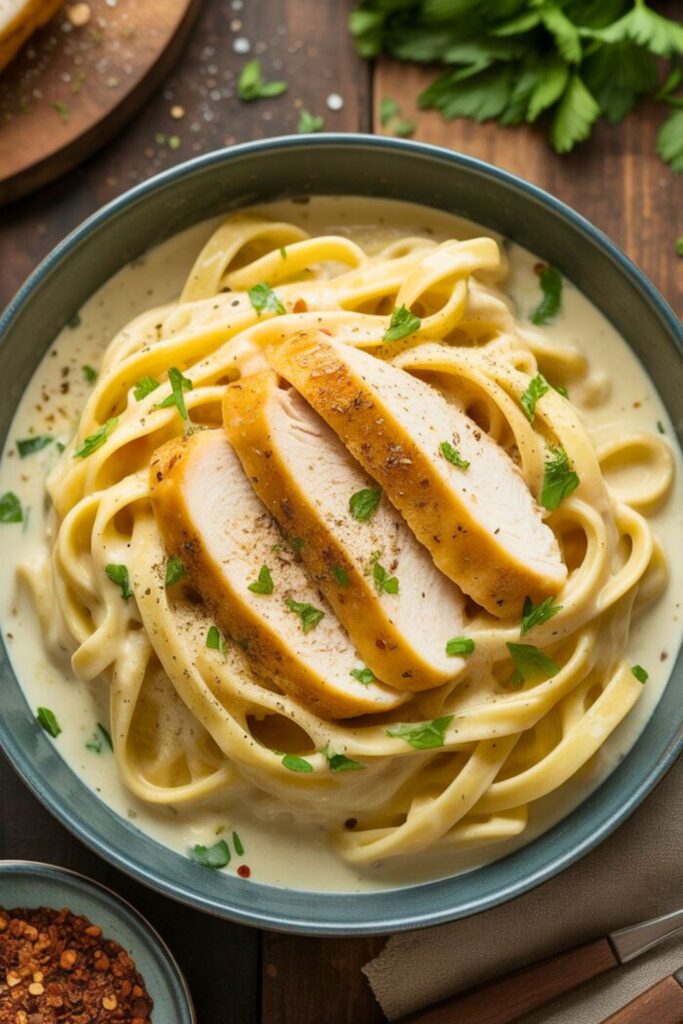
Step 1: Prep Like a Pro
Season your chicken generously and let it sit at room temperature for 20 minutes. This isn’t optional – cold chicken hits hot pan equals uneven cooking and tough results. While you wait, grate your cheese, mince your garlic, and get everything ready. Once we start cooking, things move fast.
Step 2: The Bloom Technique
Heat 2 tablespoons of butter in your largest skillet over medium heat. When it stops foaming, add garlic, thyme, and red pepper flakes. Let them sizzle for exactly 30 seconds – you’ll smell the magic happening. This is your flavor foundation.
Step 3: Perfect Chicken Every Time
Push seasoned herbs to one side and add chicken to the empty space. Don’t move it. Don’t poke it. Don’t even think about touching it for 5-6 minutes. You want a gorgeous golden crust that’ll add depth to your finished sauce.
Flip once and cook another 4-5 minutes until internal temp hits 165°F. Remove chicken and let it rest. Here’s the key: don’t clean that pan. All those browned bits are liquid gold for your sauce.
Step 4: Building the Sauce
Add remaining butter to the same pan with all those delicious browned bits. Add wine and scrape up every bit of flavor stuck to the bottom. Let it bubble and reduce by half – this concentrates the flavors and cooks off the harsh alcohol bite.
Pour in cream and bring to a gentle simmer. Not a rolling boil – that’ll break your sauce faster than you can say “disappointment for dinner.”
Step 5: The Emulsion Dance
Here’s where people usually mess up. Remove pan from heat completely. Add cheese in three additions, stirring constantly with a wooden spoon. The residual heat melts the cheese without scrambling it.
If sauce looks too thick, add pasta water one tablespoon at a time. Too thin? A bit more cheese fixes everything.
Step 6: Bringing It Together
Slice your rested chicken and return it to the sauce along with any accumulated juices. Add drained pasta directly to the pan – this is where the magic really happens.
Toss everything together off the heat, adding pasta water as needed to create a silky coating that clings to every strand. The pasta should be glossy, not swimming in sauce.
The Science Behind Perfect Creamy Chicken Alfredo
Real alfredo happens because of emulsification – the same process that makes mayonnaise and hollandaise work. You’re essentially creating a stable mixture of fat and water that shouldn’t normally want to stay together.
The starch from pasta water acts as an emulsifier, helping bind the fat from butter and cheese with the water-based elements. Temperature control is everything here. Too hot and the proteins in cheese seize up, creating that stringy mess we’ve all experienced. Too cool and the fats won’t incorporate properly.
This is why we remove the pan from heat before adding cheese. Residual heat provides enough warmth for melting without crossing into scramble territory.
The wine serves multiple purposes beyond flavor. Its acidity helps break down proteins in the chicken, creating more tender results. It also adds brightness that cuts through all that rich dairy, preventing the final dish from feeling heavy.
That tiny bit of red pepper flakes? It creates what chefs call “the tingle” – a subtle heat that enhances other flavors without overpowering them. Your guests won’t be able to identify it, but they’ll definitely notice something special happening.
Perfect Pasta Pairing for Creamy Chicken Alfredo
Fettuccine is classic for good reason – those wide, flat noodles grab sauce like nothing else. But pappardelle works even better if you can find it. The extra width means more surface area for sauce adherence.
Cook pasta until it’s just shy of al dente. It’ll finish cooking in the sauce, absorbing flavors while reaching perfect texture. Save at least one full cup of pasta water before draining – you’ll probably need more than you think.
Making Your Creamy Chicken Alfredo Restaurant Beautiful
Presentation matters more than most home cooks realize. Start with warm plates – run them under hot water and dry completely before plating.
Use tongs to create a little nest of pasta in the center of each plate. Arrange chicken slices in a fan pattern over one side. Spoon extra sauce around the edges, not on top – this keeps the pasta from getting soggy and creates visual appeal.
A light dusting of freshly grated Parmigiano-Reggiano adds color contrast and extra flavor. Finish with just a crack of fresh black pepper and maybe a tiny sprinkle of fresh parsley if you’re feeling fancy.
Wine Pairing That Actually Makes Sense
You want something that’ll cut through all that richness without competing with delicate flavors. A crisp Pinot Grigio or Sauvignon Blanc works beautifully. If red’s more your style, go light – maybe a Chianti Classico or Sangiovese.
Avoid anything too oaky or heavy. This dish has enough richness without wine adding more weight to the meal.
Perfecting Your Creamy Chicken Alfredo Technique
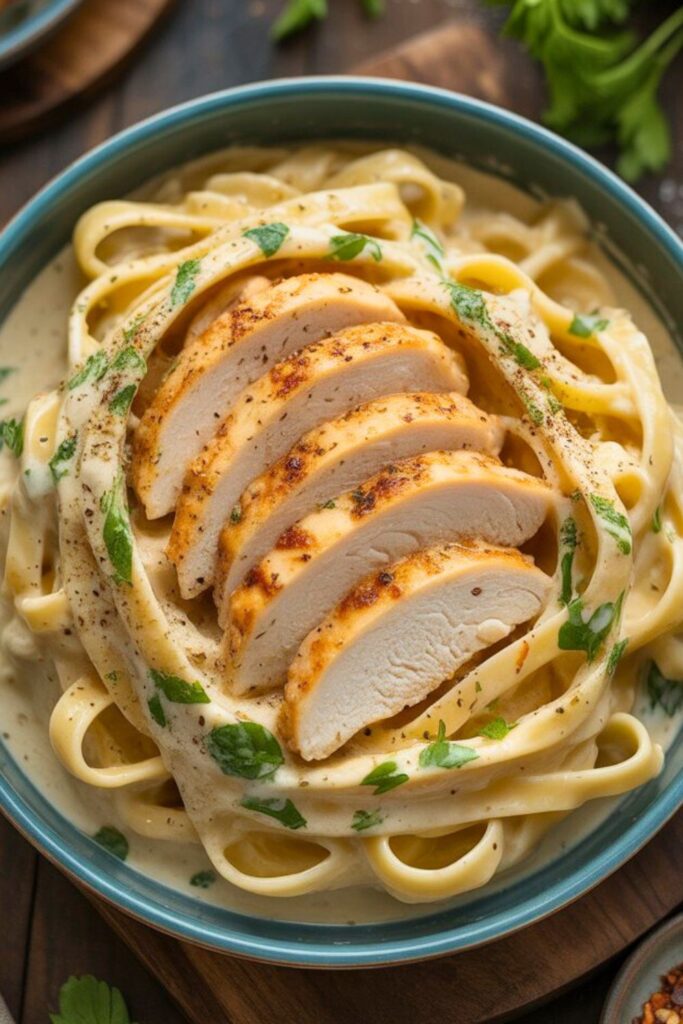
The most important thing to remember? This dish is about balance. Rich but not heavy. Flavorful but not overwhelming. Impressive but not impossible.
Once you nail this technique, you’ll find yourself tweaking and personalizing it. Maybe you’ll add some sautéed mushrooms next time. Perhaps sun-dried tomatoes and spinach for color and nutrition. The foundation we’ve built here supports endless variations.
The real secret isn’t in following this recipe exactly – it’s in understanding why each step matters. Master the emulsification technique, nail your seasoning game, and treat your ingredients with respect. Everything else is just details.
Your friends and family are gonna lose their minds over this creamy chicken alfredo. And the best part? They’ll think you’re some kind of culinary genius when really, you just learned to treat simple ingredients with the respect they deserve.
This creamy chicken alfredo represents everything great cooking should be – technique-driven but approachable, impressive but achievable, and absolutely worth mastering.
Frequently Asked Questions
Can I make creamy chicken alfredo ahead of time?
Alfredo doesn’t love reheating, but here’s how to make it work. Undercook the pasta slightly and store sauce and pasta separately. When reheating, add a splash of cream or pasta water to loosen the sauce, then combine everything in a hot pan. It won’t be quite as silky as fresh, but it’s still delicious.
Why does my creamy chicken alfredo sauce always break?
Temperature control is usually the culprit. Add cheese to sauce that’s too hot and it’ll seize up, creating a grainy, separated mess. Always remove from heat before adding cheese, and add it gradually while stirring constantly. If it does break, sometimes adding a tablespoon of pasta water and stirring vigorously can bring it back together.
Can I use chicken thighs in creamy chicken alfredo?
Absolutely, and I actually prefer them. Thighs stay juicier and pack more flavor. Just adjust cooking time – they’ll need an extra 2-3 minutes per side to reach safe internal temperature.
What if I don’t have white wine for creamy chicken alfredo?
Chicken broth works as a substitute, but add a squeeze of fresh lemon juice to mimic wine’s acidity. The sauce will be slightly different but still delicious. Never use cooking wine from the grocery store – it’s loaded with salt and tastes terrible.
How do I know when creamy chicken alfredo sauce reaches perfect consistency?
Perfect alfredo should coat the back of a spoon but still flow easily. When you drag your finger across the sauce on the spoon, it should leave a clean line that doesn’t immediately fill back in. If it’s too thick, add pasta water one tablespoon at a time. Too thin? A bit more cheese usually fixes it.

Swiftly Captions by Tina Smith — Quick, flavorful food recipes made simple, bringing fresh inspiration to your kitchen every day
